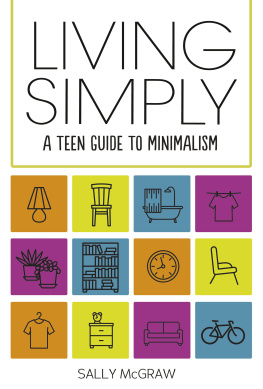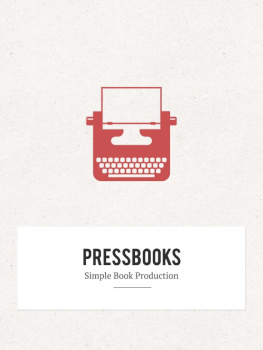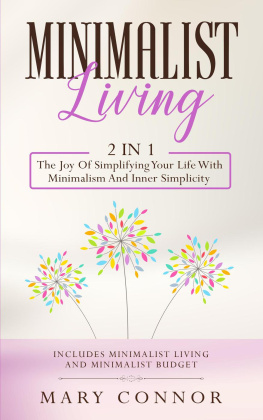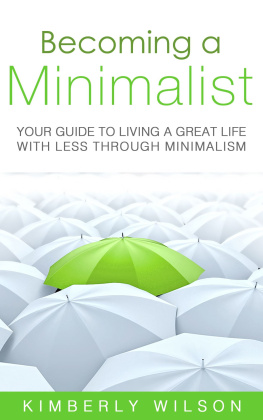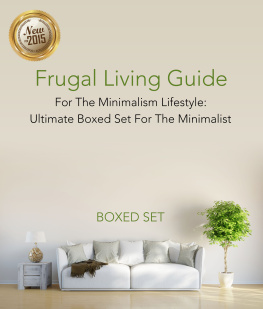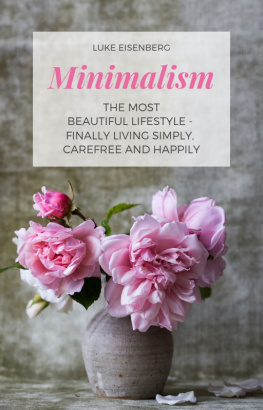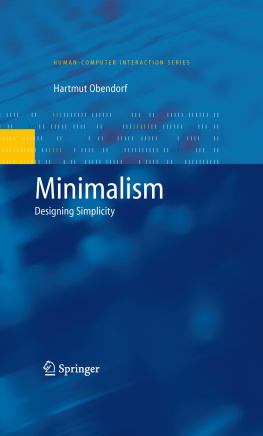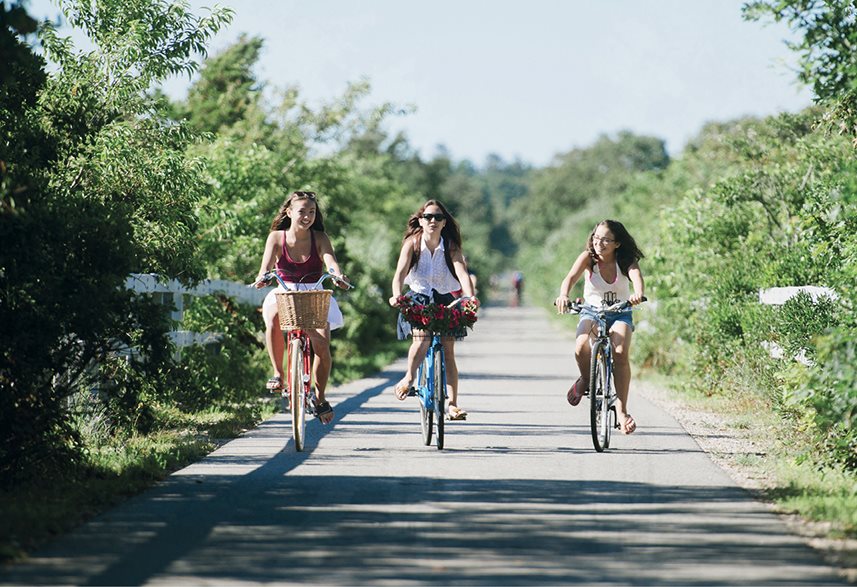Text copyright 2019 by Lerner Publishing Group, Inc.
All rights reserved. International copyright secured. No part of this book may be reproduced, stored in a retrieval system, or transmitted in any form or by any meanselectronic, mechanical, photocopying, recording, or otherwisewithout the prior written permission of Lerner Publishing Group, Inc., except for the inclusion of brief quotations in an acknowledged review .
Twenty-First Century Books
A division of Lerner Publishing Group, Inc.
241 First Avenue North
Minneapolis, MN 55401 USA
For reading levels and more information, look up this title at www.lernerbooks.com .
Main body text set in Adrianna Regular 11/15.
Typeface provided by Chank.
Library of Congress Cataloging-in-Publication Data
The Cataloging-in-Publication Data for Living Simply: A Teen Guide to Minimalism is on file at the Library of Congress.
ISBN 78-1-5415-0054-9 (lib. bdg.)
ISBN 78-1-5415-2482-8 (eb pdf)
Manufactured in the United States of America
1-43697-33489-6/7/2018
Contents
Introduction
Minimalism Matters
Chapter 1
The Roots of Minimalism
Chapter 2
Making Minimalist Choices
Chapter 3
Getting Started
Chapter 4
Minimalist Basics for Stuff You Buy
Chapter 5
Minimalist Basics for Stuff You Use
Chapter 6
Living Simply as a Life Philosophy
Teen girls pedal along the Shining Sea Bikeway in Falmouth, Massachusetts. Minimalism involves making Earth-friendly choices, such as biking instead of traveling by car.
Introduction
Minimalism Matters
M inimalism matters because you matter. Since youre reading this book, youre concerned about our planet. Youre especially concerned about waste. You probably turn off the water while youre brushing your teeth, recycle faithfully, and bike or walk everywhere you can. You might even be able to reel off a few staggering stats, such as these about how human waste is slowly suffocating our planet:
- Every year humans create 1.3 billion tons (1.2 billion t) of solid waste, better known as garbage. Experts expect that number to soar to 4 billion tons (3.6 billion t) by 2100.
- About 50 percent of all fresh fruits and veggies in the United States are thrown away uneaten. Thats about 60 million tons (54 million t) of produce every year.
- Americans discard 14 million tons (13 million t) of clothing every year. While a portion of that clothing goes to resale charities such as Goodwill and the Salvation Army, much of it goes into landfills.
Thats so much stuff that couldve been recycled or reused, and so many items that should never have been bought. Were burying ourselves in garbage and buying new things when our old stuff is actually just fine.
The good news is that many people are looking for ways to become more responsible, low-impact citizens of Earth. If a purchase or choice isnt ethical, recyclable, organic, or environmentally friendly, many of us give it some serious side-eye. Our collective willingness to step up and make smart, informed, impactful choices about what we buy, what we eat, and how we use energy are crucial steps in saving our planet.
Keep It Simple
Minimalism is a lifestyle that involves using less, minimizing harm to the environment, and owning only useful items. The philosophy focuses on the things we most value and letting go of everything that distracts us from that focus. It isnt a new philosophy, but in the twenty-first century, its gone mainstream. Authors, bloggers, and podcasters all over the world have adopted the minimalist living cause and are helping others learn how to live with less. Books about decluttering are runaway international best sellers, and minimalist bloggers such as Joshua Becker have millions of followers. The tiny house movement, which challenges individuals to live in just a few hundred square feet or less of space, has swept the United States. Some organizations focus their minimalism efforts on reducing waste. For instance, the clothing brands Eileen Fisher and H&M have created garment-recycling programs to cut down on the amount of clothing sent to landfills. Feeding the 5000, a United Kingdombased charity, sponsors huge events where perfectly edible but misshapen or blemished grocery store castoffs are cooked and eaten.
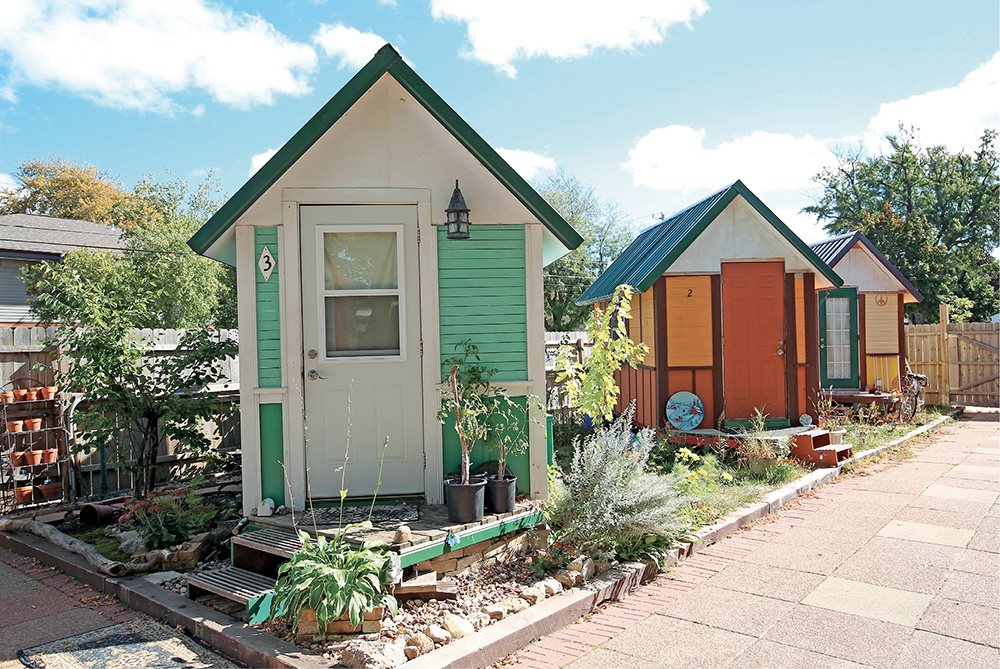
For some people, minimalism means living with less. For residents of this community of tiny homes in Madison, Wisconsin, that involves paring down possessions to whatever fits in just 98 square feet (9.1 sq. m).
When you embrace minimalism, your choices and actions can be influential. For example, when you pare down your wardrobe and other possessions, your friends and peers see that for you, flaunting new stuff isnt the only way to be cool. Younger siblings may be inspired to follow your lead and use their own money more wisely. You may have some great conversations with your parents about how spending habits matter. The ways in which you do and dont spend your hard-earned cash have an effect on virtually everyone around you.
If youd like to increase that impact, your nose is buried in the right book. This is a hands-on guide to reducing waste, buying less, and making good use of what you already have. Well talk fashion, food, and living spaces, offering suggestions for meeting your needs and fulfilling your desires in Earth-friendly ways. Well explore the difference between decluttering and true minimalist living. Well even meet teens who absolutely adore shopping, spending, and indulging who are living with less. Well dig into simple and effective ways to live a stylish, modern, compassionate life without leaving a giant, wasteful footprint on Earth.
In earlier eras, humans often grew their own food and made their own clothing. In this advertisement from 1851, a woman makes clothing using a foot-powered sewing machine.
Chapter 1
The Roots of Minimalism
D id you know that our earliest ancestors were thrifters and that they made just about everything they needed from scratch? The earliest humans were hunter-gatherers. They lived in small groups and moved from place to place, hunting animals and gathering wild plants for food. Hunter-gatherers fashioned tools from animal bones, rocks, and wood; made clothing from animal hides; and built shelters out of wood, clay, straw, animal skins, and other natural materials. If a tool broke or an item of clothing ripped, the owner repaired it with twine or thread made from plant fibers.
The first farmers on Earth lived about twelve thousand years ago in the ancient Middle East. Early farming was Earth-friendly. Families grew and processed enough food to feed themselves. If they had any surplus, they stored it or traded it. Livestock grazed on plants, and farmers used the animals dung to fertilize crops.
Cities developed shortly after the start of farming. People built almost everything in early cities, from roads and bridges to houses and government buildings, by hand with mostly local materials. City dwellers either made their own tools, clothes, and furniture or purchased them from local artisans. They patched and repaired most items as needed. If someone did throw an item away, the materialswood, animal hides, plant fibers, or other once-living tissueseventually broke down and enriched the soil. Human trash benefited the planet in those days.

